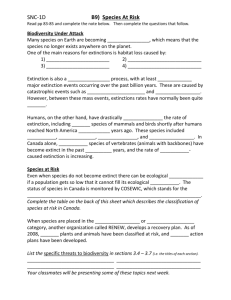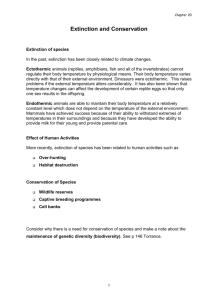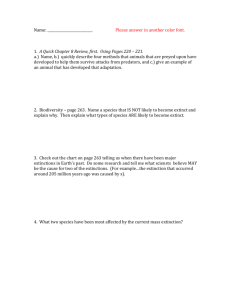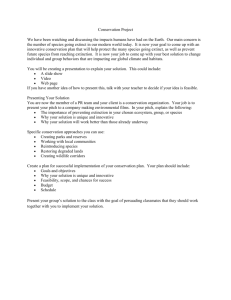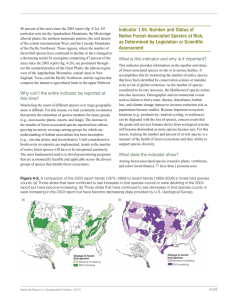Indicator 1.05.
advertisement
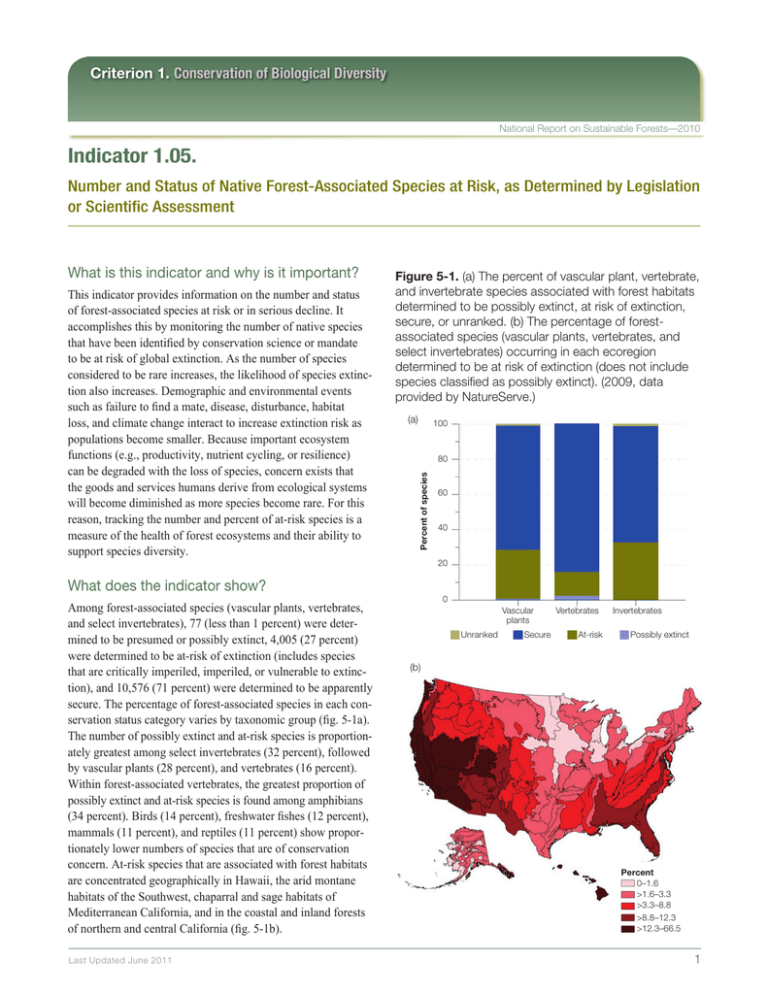
Criterion 1. Conservation of Biological Diversity National Report on Sustainable Forests—2010 Indicator 1.05. Number and Status of Native Forest-Associated Species at Risk, as Determined by Legislation or Scientific Assessment This indicator provides information on the number and status of forest-associated species at risk or in serious decline. It accomplishes this by monitoring the number of native species that have been identified by conservation science or mandate to be at risk of global extinction. As the number of species considered to be rare increases, the likelihood of species extinction also increases. Demographic and environmental events such as failure to find a mate, disease, disturbance, habitat loss, and climate change interact to increase extinction risk as populations become smaller. Because important ecosystem functions (e.g., productivity, nutrient cycling, or resilience) can be degraded with the loss of species, concern exists that the goods and services humans derive from ecological systems will become diminished as more species become rare. For this reason, tracking the number and percent of at-risk species is a measure of the health of forest ecosystems and their ability to support species diversity. Figure 5-1. (a) The percent of vascular plant, vertebrate, and invertebrate species associated with forest habitats determined to be possibly extinct, at risk of extinction, secure, or unranked. (b) The percentage of forestassociated species (vascular plants, vertebrates, and select invertebrates) occurring in each ecoregion determined to be at risk of extinction (does not include species classified as possibly extinct). (2009, data provided by NatureServe.) (a) 100 80 Percent of species What is this indicator and why is it important? Last Updated June 2011 40 20 What does the indicator show? Among forest-associated species (vascular plants, vertebrates, and select invertebrates), 77 (less than 1 percent) were deter­mined to be presumed or possibly extinct, 4,005 (27 percent) were determined to be at-risk of extinction (includes species that are critically imperiled, imperiled, or vulnerable to extinc­tion), and 10,576 (71 percent) were determined to be apparently secure. The percentage of forest-associated species in each con­servation status category varies by taxonomic group (fig. 5-1a). The number of possibly extinct and at-risk species is proportionately greatest among select invertebrates (32 percent), followed by vascular plants (28 percent), and vertebrates (16 percent). Within forest-associated vertebrates, the greatest proportion of possibly extinct and at-risk species is found among amphibians (34 percent). Birds (14 percent), freshwater fishes (12 percent), mammals (11 percent), and reptiles (11 percent) show proportionately lower numbers of species that are of conservation concern. At-risk species that are associated with forest habitats are concentrated geographically in Hawaii, the arid montane habitats of the Southwest, chaparral and sage habitats of Mediterranean California, and in the coastal and inland forests of northern and central California (fig. 5-1b). 60 0 Vascular plants Unranked Secure Vertebrates At-risk Invertebrates Possibly extinct (b) Percent 0–1.6 >1.6–3.3 >3.3–8.8 >8.8–12.3 >12.3–66.5 1 National Report on Sustainable Forests—2010 What has changed since 2003? Since the 2003 report, a broader accounting of species that inhabit forests has resulted in an increase in the number of species that are considered possibly extinct or at risk of extinction, with the greatest increase reported among vascular plants (3,644 more species). The number of species of conservation concern also increased among select invertebrates (108 more species) and vertebrates (23 more species). The sizable percentage gains among vascular plants and invertebrates (fig. 5-2a) are largely attributable to newly available data rather than from a real increase in the percentage of species consider at risk. Among the relatively well-studied vertebrates, an increase of about 0.8 percent has occurred since the 2003 report. Among vertebrate species groups (fig. 5-2b) the greatest percent gains in species thought extinct or at risk of extinction were observed among amphibians (an increase of 2.2 percent), followed by mammals (an increase of 1.0 percent), reptiles (an increase of 0.9 percent), and birds (an increase of 0.5 percent). Why can’t the entire indicator be reported at this time? Information on the conservation status of obscure species is lacking in many cases. Among all species (not just forest associated), 281 (1.7 percent) vascular plant, 14 (less than 1 percent) vertebrate, and 660 (9.0 percent) invertebrate species (select groups) have not been, as yet, assigned a conservation status category nor a habitat affinity. Given the number of species for which conservation status ranks are forthcoming, trends in the number of forest-associated species by conservation status will need cautious interpretation because gains are expected as unranked species are evaluated. Regional trend analyses were also limited by the fact that the ecoregional stratification changed from the 2003 to the 2010 reports. Figure 5-2. A comparison of the percent of forest-associated species that have been determined possibly extinct or at risk of extinction between the 2003 and 2010 reports among (a) vascular plants, vertebrates, and select invertebrates, and (b) among the relatively well-known mammal, bird, reptile, amphibian, and freshwater fish species groups. Because the conservation status of forest-associated freshwater fish species (▲) were unavailable for the 2003 report, only a single-point estimate for the 2010 report is shown. (Actual reporting dates were 2002 and 2009.) 35 35 (b) 30 30 25 25 Percent of species Percent of species (a) 20 15 20 15 10 10 5 5 Vascular plants Vertebrates Invertebrates 0 Mammals Birds Reptiles Amphibians Fishes 0 2003 report Last Updated June 2011 2010 report 2003 report 2010 report 2

